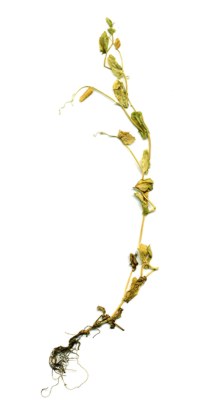Diseases
Aphanomyces euteiches Drechsl. - Aphanomyces Root Rot of Peas.
Systematic posicion.
Class Oomycetes, order Saprolegniales, genus Aphanomyces.Biological group.
Saprobiont.Morphology and biology.
The rootage and underground part of stalk on shoots and roots and stalks at height of 1-3 cm above ground on adult plants are affected. Affected areas darken and become wet. Plants turn yellow, noticeably lag in growth and development. Asexual reproduction of the fungus occurs by zoosporangia and zoospores. Primary zoospores (before leaving zoosporangium) are cylindrical, 30 x 3-3.5 mkm in size. Being released, they become rounded, turning into immobile spores, 8-12 mkm in diameter. The spores assemble at operculum of zoosporangium, forming big heads of 50 and more spores. After a dormant period (1-2 hours) the encysted spores produce secondary zoospores, being reniform or pear-shaped, having two flagella, 12-15 x 6-8 mkm in size. After active movement the zoospores encyst, then sprout with germinating tubes. Organs of sexual reproduction are oogonium, antheridium, and oospores. After conjugation of oogonium and antheridium a spherical or ellipsoid oospore with thick colored walls is formed. The oospores are 21-24 mkm in size on the average. The fungus keeps in soil or on vegetation residues as oospores to 10 years.Distribution.
Sources of the Aphanomyces Root Rot of Peas are the infected vegetation residues and soil. Aphanomyces Root Rot is a dangerous disease of roots of peas in USA, Canada, Europe (Norway, England, Sweden, Germany, Denmark), Japan, Australia. In Russia it is associated with culture of peas in humidified zones of Non-Black Earth Region, Tatarstan, Bashkortostan, Mari El, Krasnodar Territory, harming also in the Baltics, Byelorussia and Ukraine.Ecology.
Aphanomyces Root Rot is distributed in zones with sufficient and superfluous humidification and moderate temperatures. In spring the germination of oospores begins at air temperature not lower than 10-12.C and soil humidity ratio 50-60 %. Optimum temperature for the pathogen development is 21-24.C and optimum soil humidity ratio is 60-80 %.Economic significance.
The disease damage peas mainly. Harming activity is expressed in destruction of rootage and tubercles, loss of shoots, lag of plants in growth, dwarfism, decrease of food value, and deterioration of germinating state of seeds. The fungus is highly specialized, being able to infect Vicia sativa L., Phaseolus vulgaris (L.) Sav., Medicago sativa L., Trifolium pratense L. in addition to host plant. Reduction of the disease development is promoted by presowing seed dressing, early terms of sowing, land improvement and soil liming, maintenance of crop rotation (return of peas in 6-8 years), use of the predecessors lowering soil infection, and use of relatively resistant varieties.Related references.
Kask, K. 1984. Root rot of peas, caused Aphanomyces euteiches Drechsl. in Estonia. Zashchita rastenii 53: 14-24 (in Russian).Kirpicheva, T.S. 1990. Root rot of peas in Ukraine. Zashchita rastenii 3: 23-24 (in Russian).
Kotova, V.V. 1969. Root rot of peas, caused by Aphanomyces euteiches Drechsl. in the USSR. Mikologiya i fitopatologiya 3(5): 438-42 (in Russian).


